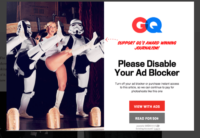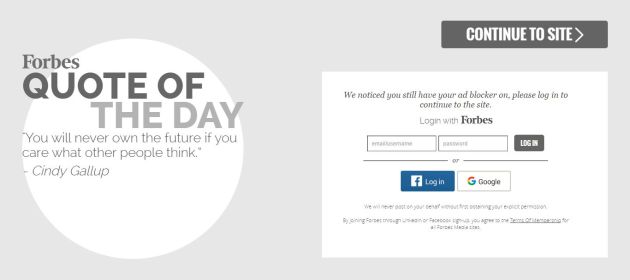With the rising use of ad-blockers by online readers, the blogosphere is full of advice on how online publishers should move away from advertising and find other ways to monetize their content. Some of the alternatives proposed by the digerati include:
- Micropayments
- Subscription
- Native Ads
- Harvest PII
- Remove Obtrusive Ads
In this blog post, I’ll examine how each of these options has fared in practice.
#1. MICROPAYMENTS

Micropayment was tried out in the late ‘oughties. As I’d written in my blog post “Micropayments – Saviors or Enablers?” at the time, media honchos had pinned their hope on micropayments to save the digital publishing industry. Unfortunately, that vision hasn’t panned out. A raft of micropayment solution providers like TipJoy and TwoNate shut down.
Apparently, many people declared in surveys that they’d pay for content but very few of them actually put their money where their mouth is.
I wonder if this trait of consumer behavior has changed in the ensuing decade. So, for the same reason that micropayments didn’t work then, it might not work now – although I’d love to be proven wrong by GQ and others who are trying it out now.
Will the recent buzz around ad blockers lead to revival of micropayments? https://t.co/QNrOENTMJw
— GTM360 (@GTM360) December 21, 2015
#2. SUBSCRIPTION

Subscription has generated revenues for some publishers like New York Times and The Guardian. However, “subscription models are very difficult”, according to Forbes Media CRO Mark Howard. In his interview with Digiday, he doubts if it can compensate for loss of ad revenues for any but the top publishers.
#3. NATIVE ADS
For the uninitiated, native ads are sponsored content packaged to have the same look-and-feel of editorial content. Most print publishers label a native ad with the term “Advertorial”. Some, like India’s leading media conglomerate Times Group, obfuscate it with misleading terms like “Times Response Feature”.
Even if publishers make as much money from native ads as regular ads, native ads have high production costs, so advertisers are not very enthusiastic about them beyond a point.
Besides, as readers start realizing that they’ve been mistaking native ads for editorial content, they’ll start ranting against native ads.
As Digiday observes in its article titled The soft approach won’t work, and other things we learned about ad blocking, “While native advertising has been touted as part of the antidote to ad blocking, it’s unlikely to scale to the extent needed to make up the revenues lost to ad blocking. Native ads often are just as likely to be blocked as display ads.”
#4. HARVEST PII
 Online publishers are finding a new way to extract value from freeloading readers: getting their email address, mobile number or some other Personally Identifiable Information (PII).
Online publishers are finding a new way to extract value from freeloading readers: getting their email address, mobile number or some other Personally Identifiable Information (PII).
In a test, Condé Nast’s Epicurious asked users of ad blockers to register on its site to read the article. Forbes asks ad blockers to log in using Facebook or Google after they try to access the site multiple times.
While it’s too early to say if this approach would work, this article and comments below it are not too gung-ho about its prospects. Which is not surprising because readers know that by giving away their emails or social logons, they’re just one step away from being bombarded by ads on even more intrusive channels like email and social feeds.
Besides, it’s technically hard to do this right and easy to appear silly when it’s done wrong. I recently clicked a hyperlink inside a Digiday email newsletter. I was taken to its website, which detected that my ad-blocker was on. Despite the fact that Digiday already had my email address, the website asked me to enter my email address again to access the article!
#5. REMOVE OBTRUSIVE ADS

There’s a lot of talk of pruning down obtrusive ad formats like preroll and interstitial videos so that UX improves and publishers earn viewers’ trust.
The FORBES CRO quoted in the aforementioned Digiday article rules out this approach because it’s exactly these obtrusive ad formats that fetch top dollar from advertisers!
How many publishers can afford to decline their most lucrative source of revenues?
Based on the above stock-taking of alternatives and my years of observing the online media industry, I’m led to believe that advertising is still the most viable business model for publishers to monetize content.
As a corollary, publishers have to take the tough step of asking their readers to disable their ad-blockers on their sites or deny content. Which is what Axel Springer, Forbes, Times of India and a few other publishers are doing.
While it’s unpleasant, the hardline stance seems to be working well:
- Axel Springer has grown its digital revenues significantly.
One more reason Axel Springer is able to grow digital revenues is its hardline stance towards ad-blockers. https://t.co/TyREEH6odC
— GTM360 (@GTM360) April 22, 2016
- Forbes has managed to have 8 million readers turn off their ad-blocker or whitelist its site.
Mission accomplished!
Until someone comes up with some other alternative to monetize content that scales as well as advertising, I guess publishers and readers are stuck with ads – and ad-blockers.
UPDATE DATED 1 DECEMBER 2021:
Five years after the above post was published, here’s a quick update on this topic: Digital advertising companies like Google, Meta / Facebook, Snap, and Bytedance / TikTok are flourishing, with a trebling or even quadrupling of their market caps during this period. Micropayments are still elusive. Paywalls have become common. Many publishers are giving a couple of free articles per month, beyond which they demand subscriptions. Very few publishers have been able to make subscriptions work and, that too, arguably only by setting egregious subscription traps that make it easy to buy a subscription but hard to cancel them e.g. New York Times. Celebrity journalists have branched out on their own with free and paid Substack newsletters. The Guardian is the only success story for donations. Many publishers run ads even on their subscriber-only content! Nobody is talking about ad-blockers – clearly the hardline stance against them has worked wonders! Ads are still obtrusive. On my personal blog, I recently set up Google AdSense. For the time being, I’ve left it in the default mode where Google decides how many ads to show per page and where to place them. My blog looks so ghastly now that I’ve stopped visiting it myself!

